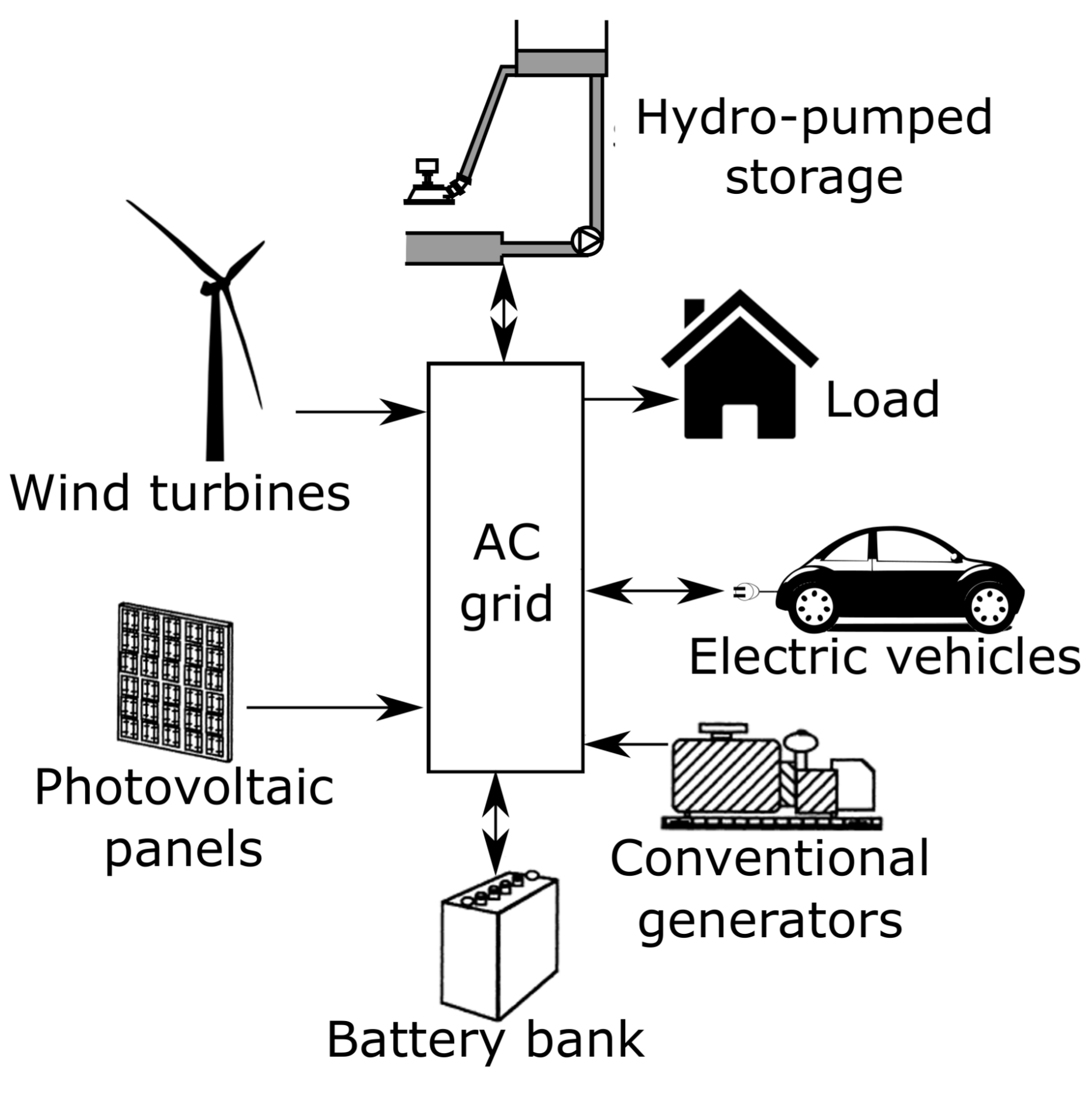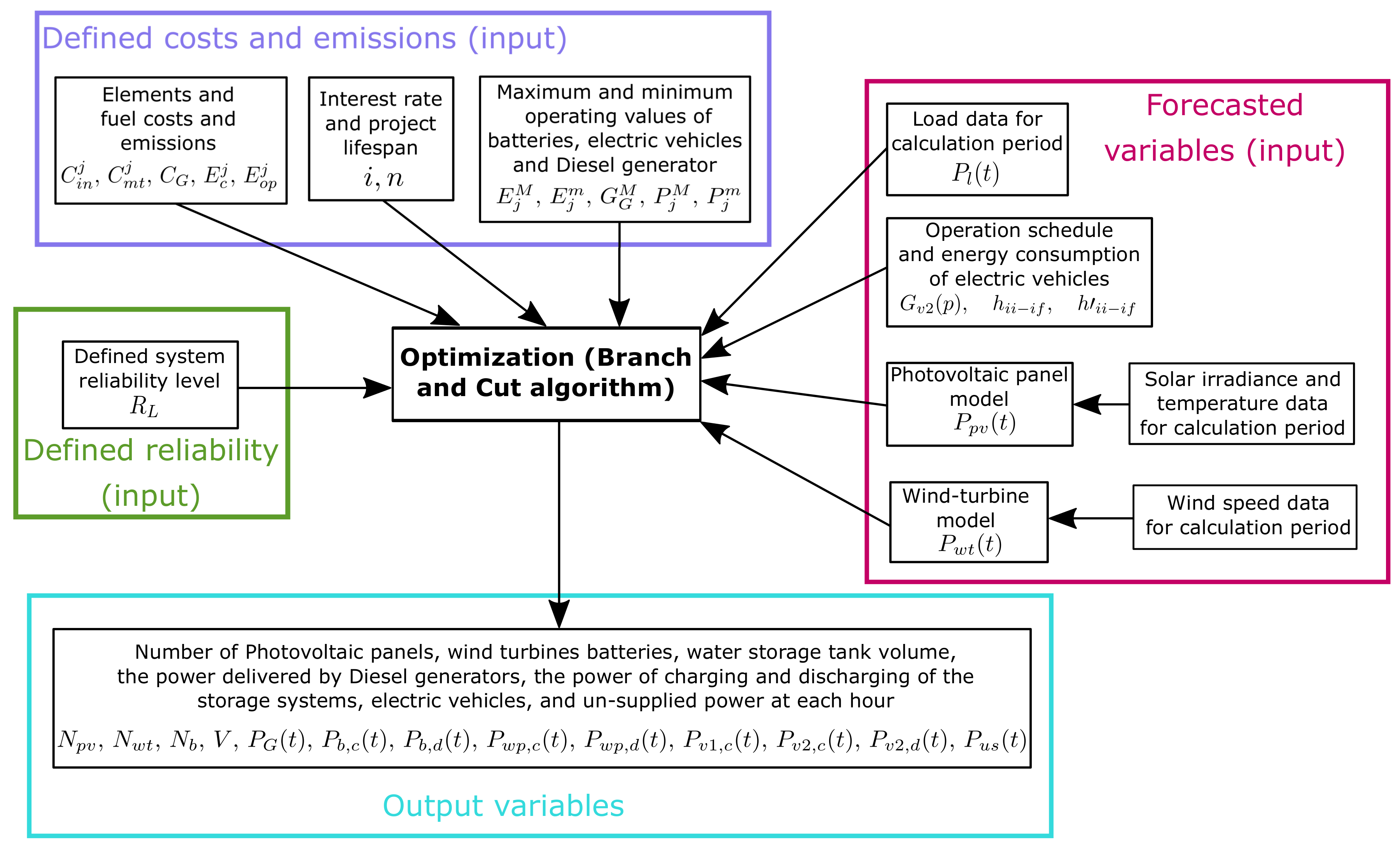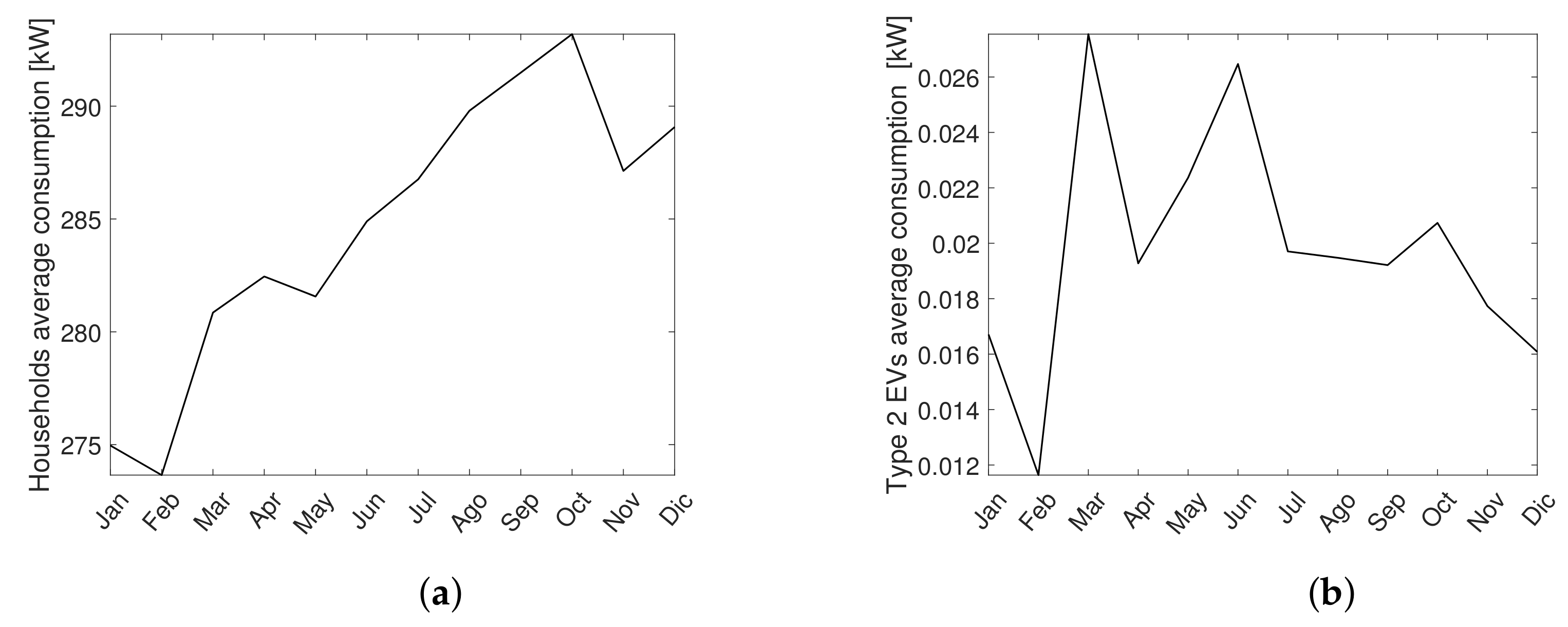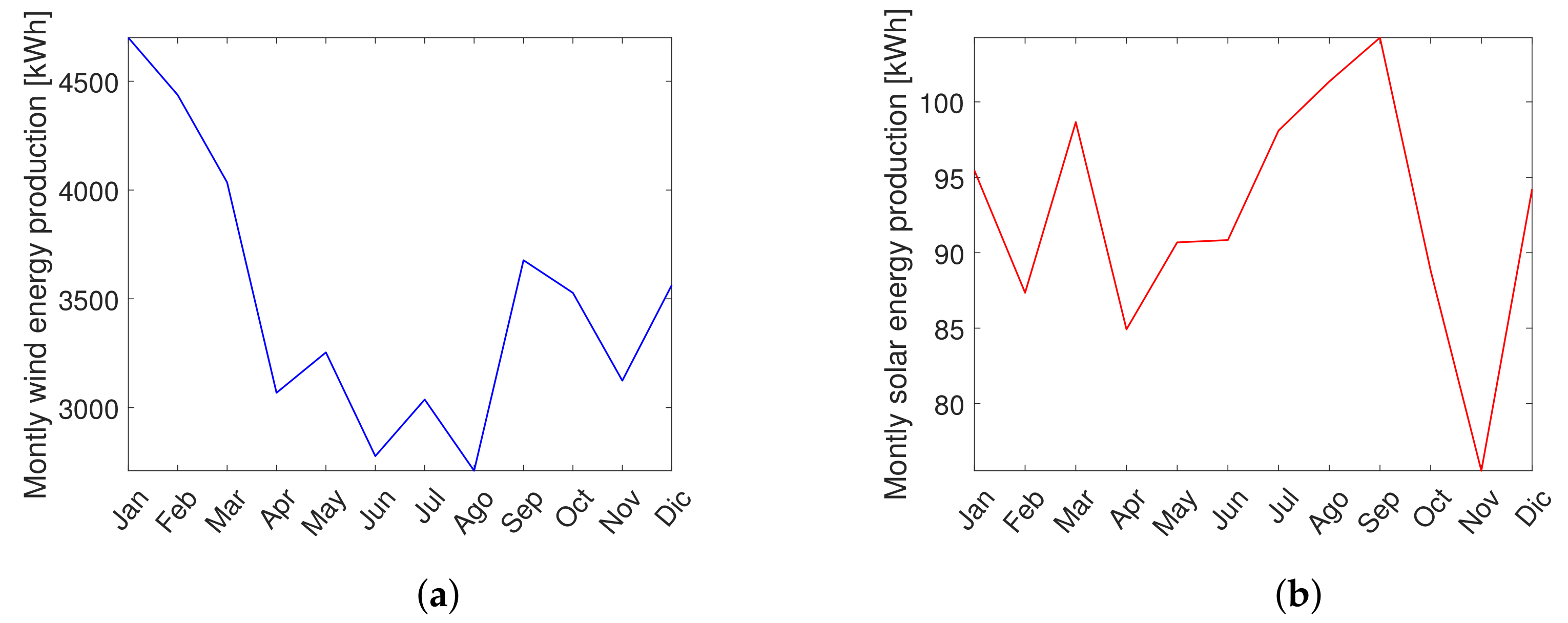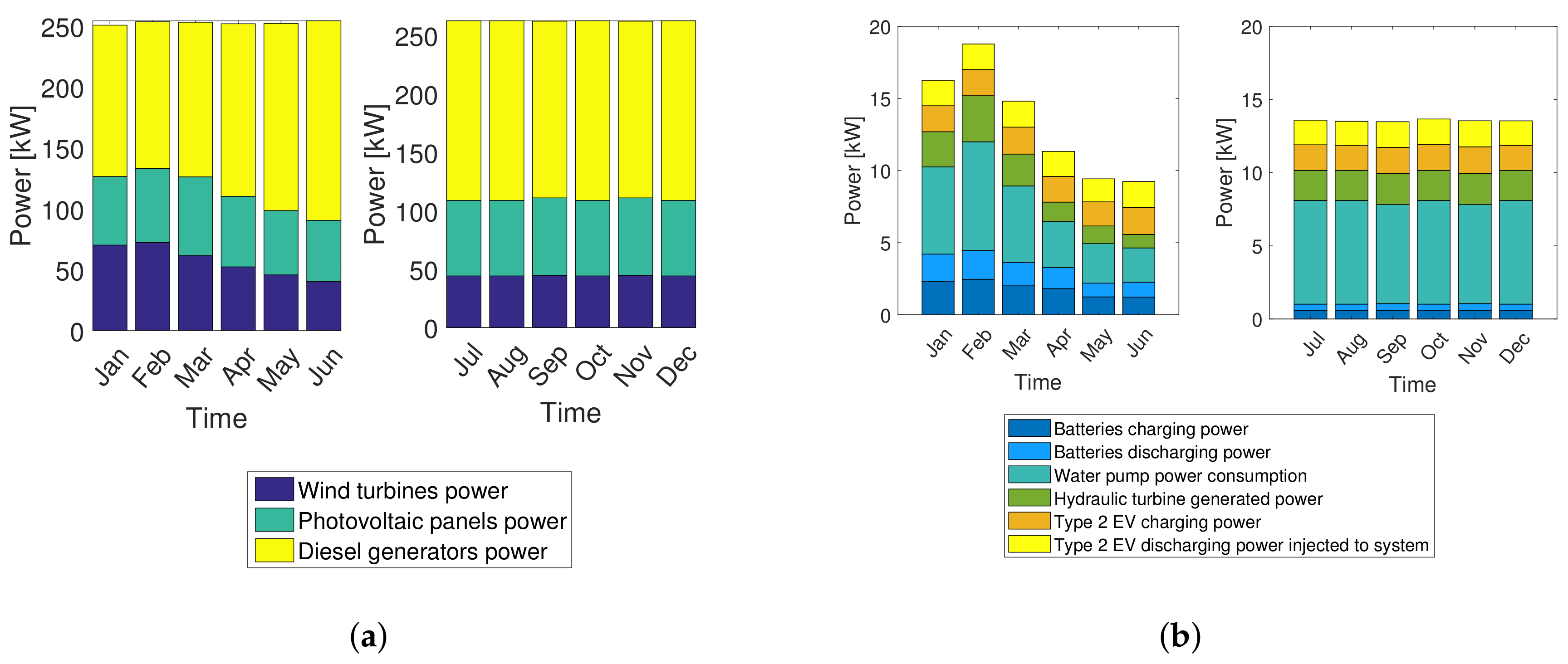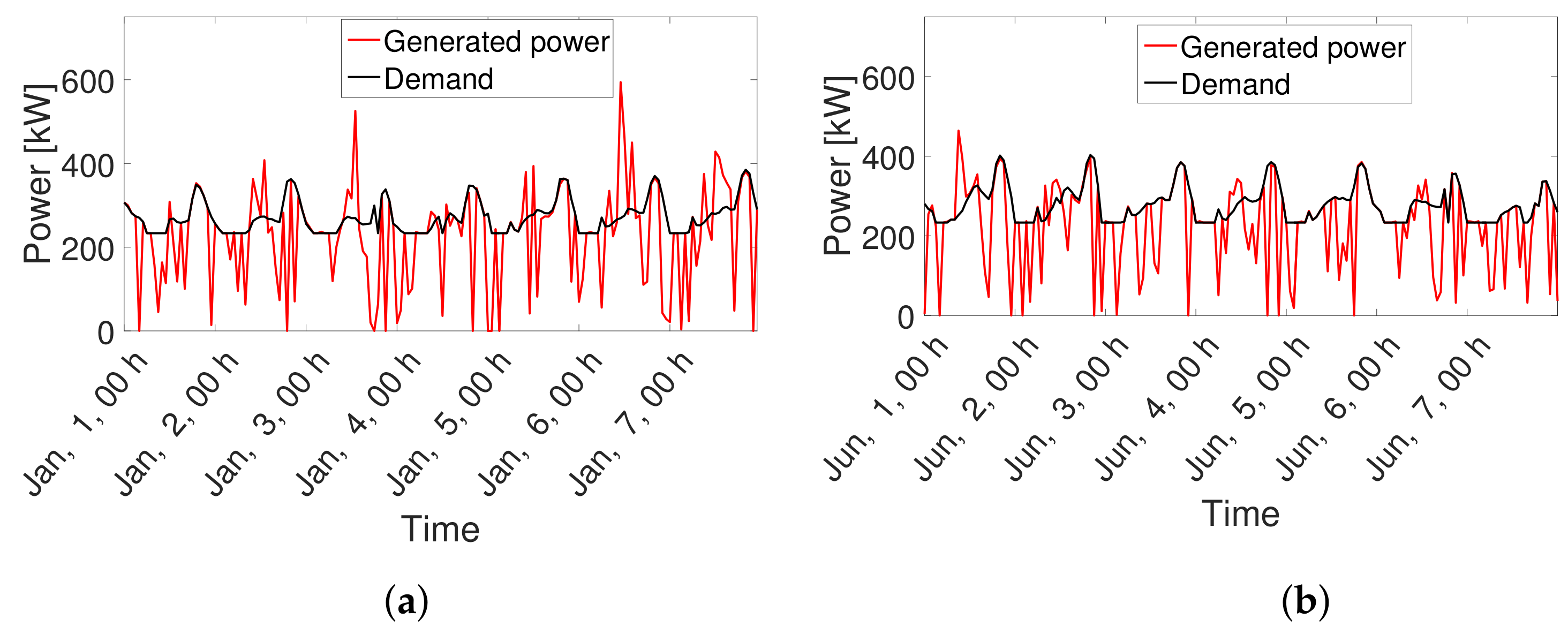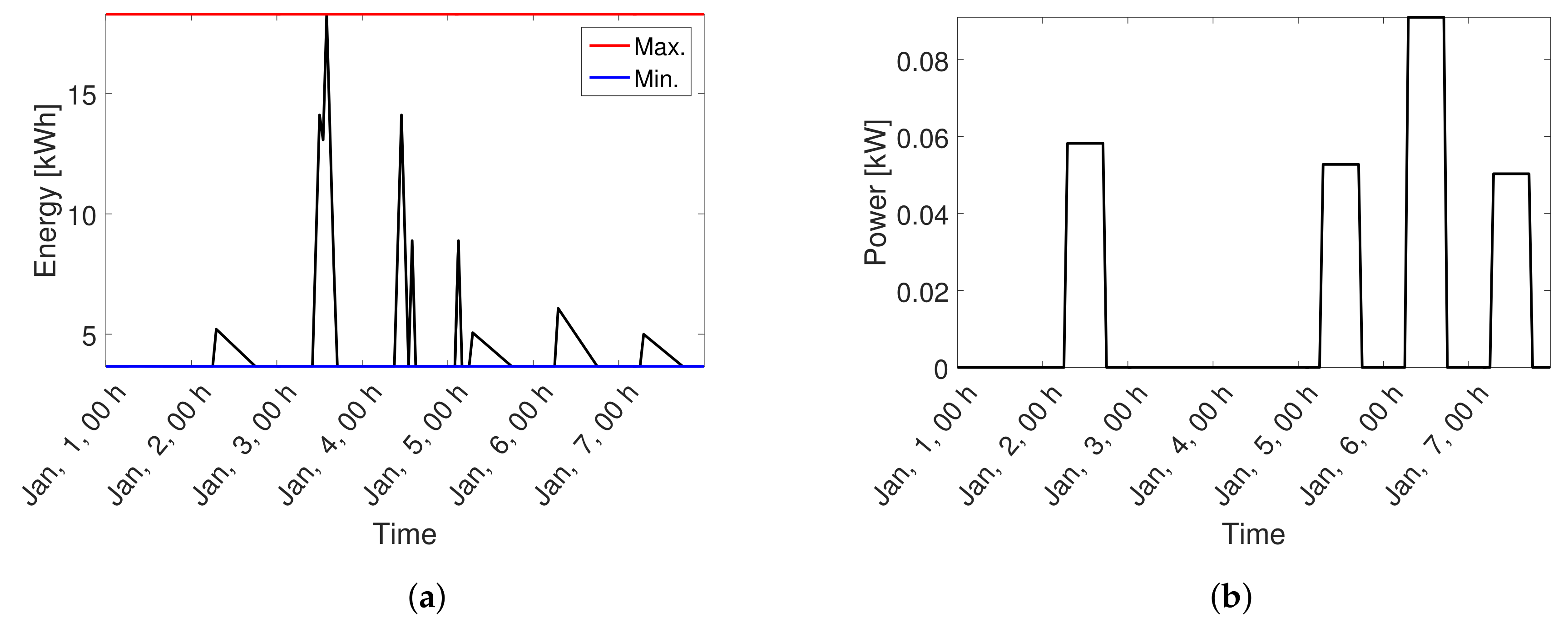1. Introduction
Nowadays, access to electricity is one of the most critical aspects when assessing the degree of welfare and development of people [
1]. For the particular case of Colombia, the population with a regular supply of electricity provided by the primary grid system is located around the big urban centers corresponding to 48% of the territory; this also means that more than half of the country belongs to the so-called
non-interconnected zones (NIZ) [
2]. Although the Colombian government has a sponsored program for fuel distribution for diesel plant operation in the NIZ, transportation problems elevate the costs and decrease the effectiveness of these solutions, and the environmental concerns also have to be accounted for [
2]. In this context, many alternatives have been proposed for decreasing the economic and environmental consequences of fuel-based energy sources in the country [
3]. These alternatives include the use of hybrid microgrid systems involving renewable energy sources and the existent diesel plants, which emerge as a promising initiative for the increment of the electricity access in Colombian non-interconnected zones [
2].
As defined in [
4], microgrids can be considered as systems composed of loads and at least one element of small-scale distributed generation (DG) or storage with the ability to operate disconnected from the primary power grid. As the interest in microgrids grows, aspects such as the optimal configuration of distributed generation or the adequate management of the energy sources arise as research questions. Several works have addressed those issues [
5,
6], with microgrid design approaches classified as deterministic or stochastic according to the modeling of input variables such as expected demand and weather forecasting [
7]. Microgrid design also involves the determination of the combination of elements making possible the fulfillment of the power balance in the microgrid according to some predefined criteria. The search for the optimal microgrid configuration involves mainly enumeration techniques (used for the popular design software HOMER
®), iterative approaches, and artificial intelligence methods [
8]. However, each technique has disadvantages such as the high computational times, the lack of multi-objective cost functions, or the convergence towards local minimum because of the non-convexity of the formulated problems [
9]. Despite considerable interest, the optimal microgrid design problem remains an open research area.
In this context, the microgrid application for electricity generation in rural zones faces additional challenges. For the population of the Colombian NIZ, the joint action of storage and generation elements must be able to supply the demanded energy. These storage elements can be battery banks, hydro-pumped systems, or even electric vehicles (EV). The consideration of EV operation in power systems constitutes a challenge that has been widely discussed, mainly due to the worldwide efforts for reducing fossil-fuel dependence and greenhouse gas emissions [
10,
11]. According to Wappelhorst et al. [
12], the use of EV should be considered a priority to reduce energy consumption around the world.
In the specialized literature, the authors of [
13,
14] presented comprehensive summaries of the different strategies and research issues on integration of EVs in power grids. Generally speaking, vehicle-to-grid (V2G) connection mode enables the electric vehicle to participate as both a distributed source and a controllable load for the grid [
14]. Several works have explored the operation of EV in microgrids; some of the specific issues and technical challenges related to EV role in microgrids are presented in [
15,
16,
17]. In particular, the expected operating costs of a microgrid dealing with EV and responsive loads with the participation of distributed renewable energy sources were calculated in [
10], including carbon emissions. The mix of different generation sources decreases both the overall microgrid costs and the uncertainties in solar and wind sources. Furthermore, the work presented in [
18] considers the inclusion of EVs in a microgrid composed of diesel generators, fuel cells, microturbines, and photovoltaic panels. The power delivered by diesel generators and the power exchanged between EVs and power grid are calculated through an optimization process that minimizes the operation and emissions costs.
Despite the recent interest, there are not many works studying the application of EVs in rural scenarios and their inclusion from the microgrid design stage. Many of the reasons for this lack of research seem to involve topics such as the high purchase price of the EVs and the lack of the infrastructure (charging stations, replacement parts, and qualified technical operators) to support the integration [
19]. However, the potential for development in non-urban scenarios is real. According to Wappelhorst et al. [
12], some of the benefits provided by electric vehicles in urban areas (such as improving public transport in the community, reducing pollutants, etc.) are also feasible and replicable for rural environments. In this sense, this work intends to explore the inclusion of EV in an isolated microgrid for a rural environment. In fact, from the results of Falcão et al. [
20] indicating that EVs as storage systems reduce the microgrid operational costs, this work extends the inclusion of EVs into the design stage of the microgrid to determine the impacts in the microgrid sizing. The proposed design methodology for hybrid isolated microgrids uses an iterative optimization method for solving the unit commitment problem in the microgrid, including the EV, as in [
10,
18]. We extend the latter works by including the rated power of the microgrid elements as decision variables in our optimization. Hence, both the optimal planning and optimal dispatch problems can be addressed simultaneously.
The proposed design methodology was applied in a Colombian rural community, considering a microgrid composed of a diesel plant, solar photovoltaic (PV) panels, wind turbines, batteries, a hydro-pumped system, and EVs. The role of EVs in the rural community is envisioned as public service vehicles, performing tasks such as the transportation of the staff of a hospital or a public institution from a central station to the attention point. Two operational modes for EVs are studied: EVs that only constitute additional loads for the microgrid, and EVs that provide ancillary services.
This article is organized as follows.
Section 2 describes the modeling of the generation elements composing the hybrid microgrid.
Section 3 presents the formulation and solution of the optimization problem for microgrid design. The study case for the isolated microgrid design is described in
Section 4. Finally, the analysis and discussion of the results are shown in
Section 5.
2. Modeling of Microgrid Elements
The proposed microgrid is composed of a diesel generator, a battery bank, a hydro-pumped storage system, solar panels, wind turbines, and EVs. A schematic figure of a hybrid microgrid such as the one considered is illustrated in
Figure 1.
In this section, only the models for EV are discussed in detail. The models for the remaining microgrid elements come from the current literature. The models for wind turbines, batteries, and diesel generators are from the work of Maleki and Askarzadeh [
21], the photovoltaic panels use the model described in [
22], and the hydro-pumped storage can be found in [
23].
2.1. Modeling of Electric Vehicles
As described above, the microgrid to be designed is proposed for an off-grid system, intended for supplying electricity for a rurally isolated area. This fact defines the pattern consumption of electric vehicles and the strategy for their integration with the power grid. The assumption is that electric vehicles will provide a transportation service for the community public institutions functionaries, as this eliminates the dependence of fossil fuels that must be transported to the remote area and decreases the carbon emissions [
12]. For rural zones, small-sized EVs are considered as the population incomes are usually low, the traveling distances are short, and motorcycles do not cover all the transportation needs of the people [
24].
In this context, one vehicle is assigned to each relevant institution in the community. As suggested in [
25], central community institutions usually include the following: offices of local, state, and government agencies, religious institutions, cultural institutions, community centers, hospitals and public health service, educative centers, and public sports facilities. In addition, as the electric vehicles considered are of low capacity, it is feasible to assume a low rate of charge for them (less than 2 kW/h). Therefore, the existence of a particular charging station is not required, and the vehicles could be charged with a typical home circuit of 220 V. From their role in the electric microgrid, two types of EVs are considered: Type 1, acting as dynamic loads, and Type 2 with active participation in the grid as additional storage elements.
2.2. Type 1 Electric Vehicles
These vehicles perform as additional loads in the grid power balance. The microgrid system will provide the required energy to this type of EV to achieve the full charge in the charging schedule. The energy management system will dynamically assign the charging power according to resource availability. Type 1 EVs are intended for the use of institutions providing priority care services in the community, such as hospitals and police stations. The charging schedule will be scheduled according to the working hours of each institution.
2.3. Type 2 Electric Vehicles
Type 2 EVs participate as additional storage systems during the parking hours. As a design condition, a minimum level of charge must be guaranteed at the beginning of the daily working hours in order to execute the programmed trips. These vehicles will be assigned to the offices of local institutions such as the mayor’s office and deputies since these entities do not need to deal with unforeseen situations as frequently as the hospital and the police institutions. Therefore, recognizing the stochastic nature of the driving pattern for the Type 2 EVs, the daily consumption of these vehicles will be calculated using a probability density function.
The daily energy consumption of Type 2 EVs determines the surplus energy in their batteries, which will be delivered to the network again if the system requires it. According to Wu et al. [
11], the daily travel distances of electric vehicles used by office staff behave as a Log-normal stochastic process, based on the travel distances recorded by the National Household Travel Survey in [
26]. Thus, a Log-normal probability density distribution
is used to approximate the daily driving distances:
where
d is the distance traveled by a vehicle during a trip (km),
is the average traveled distance at the design period, and
is the standard deviation of the traveled distances. The parameters of the Log-normal function are estimated from previously known travel distances of the designated institution’s schedules or assuming the execution of a given number of travels to the neighboring places or towns near to the operating region.
With the Lognormal distribution function already characterized, daily traveling distances
(being
p the number of days in the design period) are randomly generated for the whole design period, and the same daily routes are assumed for all the Type 2 EVs. Then, these distances are multiplied by two to represent the round trip distance. In addition, several trips can be performed during the same day; hence, the vector
of the number of trips per day is randomly generated using a binomial probability distribution. Thus, the daily energy consumption
of each Type 2 EV is:
In Equation (
2),
is the energetic consumption produced by driving an EV (kWh km
−1). The equation of battery energy for a Type 2 EV (
) is analogous to the equation of the energy in the battery bank in [
11]. However, for electric vehicles, the efficiency of charging and discharging of the battery is assumed to be 100%. This gives the following equation:
where
N is the number of time steps in the design period,
is the self-discharge coefficient of the battery,
is the charging power, and
is the discharging power of the batteries at the time step
t. Besides, the initial charging of the batteries of electric vehicles
is assumed as the minimum energy level.
3. Formulation of the Optimization Problem
The variables calculated by the optimization are classified as size variables and dispatch variables. The dispatch variables are the power delivered by the Diesel generators at each time step ; the charging and discharging power of the battery bank at each time step denoted by and ; the power consumption of the water pump and the power generated by the hydraulic turbine of the hydro-pumped storage system at each time step, denoted by and ; the charging power of Type 1 EVs at each time step ; the charging and discharging power of Type 2 EVs at each time step, and (only the charging power is considered as a decision variable for Type 1 EV); and the unsupplied demand at time step . The designer defines the number of EVs of each type as input data.
Size variables are the number of photovoltaic panels
, the number of wind turbines
, the number of batteries in the battery bank
, the water storage tank volume
V, the rated power of the pump
and the rated power of the hydraulic turbine
. Vector
x lists the decision variables as:
Under the assumption of diesel generation already existing in the rural community of microgrid operation, the number of diesel generation units is not included in the decision variables. Hence, the initial diesel generation investments are also not considered.
3.1. Objective Function
A multi-objective weighted function was employed to calculate the design with the lowest possible cost. Two objectives compose this function: the total yearly system cost (
) and the total yearly system emissions (
), with the latter weighted by the factor
. The objective function
f is presented in Equation (
5).
The designer must define the value of the emissions weight coefficient concerning the cost associated with the
emissions. Here, this cost is extracted from the
Negotiation European System [
27] at the microgrid location.
3.1.1. Total System Cost
For the time period accounted for in the design, the total system cost is calculated as in [
28]:
where
is the annualized initial investment cost,
is the interest rate,
n is the project lifespan,
is the maintenance cost, and
is the cost associated with diesel generation. The annualized initial investment cost (
) is calculated as indicated in Equation (
7):
In Equation (
7),
is the number of units of the type
j element. Sub-index
j takes the following values:
for wind turbines,
for photovoltaic panels, and
for batteries of the battery bank. In addition, sub-index
indicates a charging state of the storage system and
indicates a discharging state. The term
is the initial investment cost for the type
j element, and
is the capital recovery factor.
In addition, investment cost includes the replacement cost
for elements with a lifespan lower than the project lifespan (batteries and converters of both photovoltaic panels and batteries) and the cost
of the occupied land by the microgrid elements. This latter cost is associated with the use of the land, and it is calculated by the following expression:
where
is the land price index and
is the area occupied by the generation element of type
j. The maintenance cost (
) is calculated as:
where
is the maintenance cost for element
k. The cost associated with the fuel for diesel generation is given by Equation (
10):
In Equation (
10),
T is the number of time steps in one year,
is the consumption of the diesel fuel at each time step, and
is the fuel cost at each time step.
denotes the cost of the lubricant (which is assumed as constant) and
is the diesel generator lubricant expense, which is related to fuel consumption by the following expression:
In Equation (
11),
denotes the power delivered by the diesel generator in
. Equations (
10) and (
11) were both taken from [
29].
3.1.2. Total Carbon Emissions of the System
The design problem assumes the microgrid generating
emissions at both the construction and operation stages only. The emissions during the operation stage are exclusively due to diesel fuel combustion.
Equation (
12) shows the total calculation of
emissions, where
is the rated power of the type
j element,
represents the
emissions produced by construction of the type
j element,
is the maximum energy capacity of the type
h storage system, and
denotes the
emissions produced by diesel fuel combustion.
3.2. Constraints
The optimization problem has constraints that determine the requirements for its solution. Constraints come from operational conditions of the elements and aspects such as the reliability in the energy supply. The following subsections describe the mathematical expressions for the constraints considered in the microgrid design.
3.2.1. Design Constraints
These are the constraints related to the nature of the design problem and operational limits of the generation elements. First, all decision variables must be positive values, and the variables related to the number of elements must be integer numbers.
The energy stored in the battery bank and EV batteries must remain between the allowable maximum and minimum limits:
In Equation (
15),
is the energy stored in the type
h storage system at the time step
t (with
for battery bank and
for batteries of Type 2 EV).
and
are the minimum and maximum energy capacity of the type
h storage system, respectively.
The energy stored in the the water tank
is limited by the tank capacity:
The dispatch variables must be kept between defined maximum and minimum values:
In Equations (
17)–(
20),
is the total rated power of diesel generators and
and
are the maximum charging and discharging power of the type
h storage system, respectively. The variable
denotes the load demanded in the microgrid at each step time.
3.2.2. Reliability Constraints
The reliability constraint is established in terms of the probability (
) of loss of power supply. This probability is defined as the ratio of the total unsupplied demand to the total demand, over a chosen design period, as Equation (
21) indicates.
The designer must define the value of the system reliability level denoted by
. This variable is the lower bound for the probability of loss of power supply. Thus,
indicates the minimum demand that the system will be able to supply. A complete expression for the loss of power supply may involve the representation of factors such as weather forecasts, demand and generation prediction, reliability indexes and equipment failure rates, similar to those performed in long-term planning studies [
30].
3.2.3. Constraints for Electric Vehicles
Type 1 EV The operating period for the institution with assigned Type 1 EVs is between hours
to
, and the non-working hours are between the interval
and
. For a full charge, the energy injected to a Type 1 EV at the non-working period must be equal to or higher than the maximum allowed energy
. This condition is set in Equation (
22), where
is the maximum capacity of batteries of Type 1 EVs, and
and
denote the initial and final non-working hours for type1 EV, respectively.
In addition, the charging power must be zero during the working period, because the vehicles are in operation at that moment. This condition is set in Equation (
23).
Type 2 EV The operating period for institutions with assigned Type 2 EVs is between hours
to
, and the non-working hours are between the interval
and
. The available power to discharge in a Type 2 EV
must equal to or greater than the daily driving average power consumption at the working hours. This average power consumption is obtained by dividing the total daily energy by the number of working hours, as indicated in Equation (
24). The charge and discharge process of Type 2 EV batteries must comply with Equations (
24) and (
25).
The charging power of Type 2 EVs at working hours must be zero every day. This condition is expressed as follows:
In addition, system power balance must condition the exchanged power with the grid by Type 2 EVs at the non-working hours from
to
. This constraint is indicated in Equation (
26), where
is the power discharged by Type 2 EV to the grid at the non-working period.
3.2.4. Constraints for Diesel Fuel Availability
The last constraint deals with the unavailability of power from diesel generators due to factors such as fuel exhaustion, loss of line connectivity, or equipment failure [
5]. For a broad representation of these situations, an average daily energy value of
is set as the upper bound for the daily energy supplied by the diesel. Equation (
27) describes daily energy delivered by diesel generators, where
and
are the initial and final hour for the days covered by the design period, respectively.
3.3. Solution Method
The cost function of the optimization problem in
Section 3 has both linear and convex characteristics. These features come from the maximum point-to-point function
of a positive constant, as indicated in Equations (
7), (
9) and (
12). Additionally, this problem has a mixed-integer nature, as integer numbers represent the amount of photovoltaic panels, wind turbines, batteries, and the volume of the water storage tank. In addition, variables for the power dispatch of each element are real-valued. Under these conditions, the
branch and cut method was used to solve the resulting mixed-integer problem. Optimization was performed with software CVX in Matlab
® using Gurobi
® solver [
31].
Figure 2 provides a graphic representation of the proposed solution method, summarizing all the involved variables.
4. Description of the Case of Study
The Colombian rural village of Unguía was selected to illustrate the application of the proposed microgrid design methodology. Unguía is a community located in the north of the Chocó department, at 478 km by waterway from Quibdó, the state capital. This rural community has an estimated population of 15,200 inhabitants [
32], with around 31% of them in the urban area. The urban area has about 900 households, of which the 78% have access to electric service provided by two 475 kVA diesel generators. Unguía has public entities such as the Mayor’s Office; the Agrarian Bank; the Department for Social Prosperity; the secretaries of government, finance, and agriculture; a police station; and a hospital. In addition, there is an active presence of private actors, such as associations with legal status.
This community was selected based on the study by Gómez [
33], highlighting Unguía as a good option for the implementation of solar and wind generation alternatives in Colombia. Weather variables and the demanded load were taken from 2015 data to perform the microgrid design. Information about demanded load was provided by Instituto de Planificación y Promoción de Soluciones Energéticas para las Zonas No Interconectadas [
34]. However, these data series have periods when the demanded load was 0 kW. During these periods, the zero demand was replaced by the average weekly consumption obtained for days with total supply. The design scenario involves five small-sized EVs (Renault Twizy model), distributed as follows: the hospital and the police employ two Type 1 EVs, and the mayoralty, the court and the Secretary of Government use the remaining three vehicles as Type 2 EVs.
The Lognormal distribution parameters and for Type 2 EVs were calculated by matching the data of travel distances with this distribution. The travel distance data were calculated as the average distances between the mayoralty, the court, the secretariat of government, and the rural villages that can be reached by road. In this way, the obtained parameter values were 1.44416 y 0.630016. Furthermore, the energy storage limitations in EV batteries only allow for up to two trips per day, according to the distance to the furthest population. Hence, the number of trips per day was randomly generated using a binomial probability distribution with parameters and .
The operating period for the Type 1 EV was established from Monday to Sunday between 7:00 and 19:00. Besides, Type 2 vehicles would be operating from Monday to Friday between 8:00 and 18:00, in concordance with the schedule of public service entities at Unguía [
32].
Figure 3a shows the monthly average of demanded load and
Figure 3 shows the average power consumption by Type 2 EV. The total energy consumption of both elements was obtained by multiplying the average values by the number of hours in the month.
According to
Figure 3b, power consumption of Type 2 EVs is much lower than the demanded power by household users (0.0044% of the latter). This behavior is expected, as 909 homes have a more significant power consumption (
Figure 3a than only three small-sized electric vehicles, even for a rural community.
4.1. Meteorological Variables
A deterministic approach was used for weather forecasting, assuming the same behavior of previous years. Data time-series recorded from Unguía weather variables in 2016 approximated the weather conditions for the design period. These wind speed and temperature data were provided by IDEAM, a state entity in charge of environmental studies [
35]. The solar irradiance incident on the photovoltaic panels at Unguía was obtained from the NASA database [
36] through the software HOMER
® [
37] for 2016. The hourly horizontal surface solar irradiance data series were calculated synthetically from the monthly average irradiance, through the application of the Graham algorithm. Calculations assumed the same tilt (5.99
) and azimuth (180
) angles for all photovoltaic modules.
Figure 4a,b illustrates the monthly energy production reached with one wind turbine and one photovoltaic panel at Unguía.
4.2. Parameters for Total Cost Calculation
The parameters assumed for calculation of total system cost were: time steps of 1 h, an annual interest rate
of 5%, a project lifespan
n of 20 years, and a weight coefficient of emissions
of
. This latter value corresponds to the annual average emissions cost for the European Union, set by SENDECO
2 for 2015 [
27]. The complete list of the parameters for microgrid elements is presented in
Table A1 in
Appendix A, including the respective cost values enunciated in
Section 3. In particular, the diesel fuel cost
was estimated from the methodology established in [
38]. Fuel cost varies for each month of the year and it is also described in
Table A2 in
Appendix A.
6. Conclusions
This paper describes a methodology for the inclusion of EV in an isolated microgrid, from the design stage. These EV are intended for use mainly in a rural environment, and some of them can provide ancillary services to the microgrid. The village of Unguía (Colombia) was used as a case of study to illustrate the application of the methodology. The Unguía microgrid was designed using hourly-sampled climate and demanded power data for one year. For ease of calculation, the one-year design period was divided in two periods of six months. The best design in terms of system costs was the microgrid obtained for the period between January and June. However, this same microgrid would not meet the requirements for the period from July to December. Thus, the recommended design for implementation would be the resulting microgrid for the period from July to December, which satisfies the most restrictive demand conditions. The Levelized Cost of the energy in the resulting design is still almost eight times higher than the electricity price at Unguia, and further strategies are needed to lower this indicator in the proposed configuration.
The inclusion of electric vehicles at the design stage of the microgrid is recommended. Beyond considering the EVs merely as additional loads, they could generate savings in the total annual costs of the network when given the capability of becoming part of the storage system in idle hours (when transportation service is not being provided). In addition, the integration of EV reduces the use of diesel generation and increases the number of wind units due to the long periods of high availability of the wind resource. The resulting energy production makes the inclusion of wind power cheaper, as the surplus of energy is stored in the EV. Besides, there is also an increment in the pump and the hydraulic turbine rated powers of the hydro-pumped storage system. Additionally, from the operational stage point of view, the consideration of EV will help to the public institutions of the rural Unguía community to overcome the fossil fuel dependence for its transportation tasks.
At last, a final recommendation is related to the use of the broadest possible computing horizon to perform the design of the microgrid. This is because the complexity of the problem is proportional to the square of the number of decision variables. In this case, a six-month time horizon was the maximum allowable design period.
